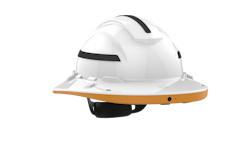Both wearable technologies and wireless connectivity via 5G or other cellular or Wi-Fi networks are growing trends in industry, particularly for field service professionals working in spatially expansive or hazardous locations. The two technologies often go hand-in-hand, with wearables such as augmented reality (AR) headsets allowing workers to access hands-free schematics, instruction manuals, or real-time audio/video feeds for remote assistance from subject matter experts, while improved wireless connectivity makes a reliable link-up possible. The benefits have proven invaluable in rough-and-tumble sectors such as oil and gas, where workers may need to receive a hands-free remote assist while embroiled in potentially risky work.
In line with these trends, Guardhat, a supplier of connected safety products, recently announced that its IS-HC1.1 Communicator Hardhat has received IECEx and ATEX Zone One safety certifications. Zone One environments are classified as areas in which hazardous explosions could possibly occur.
The HC1 is an intelligent hardhat that provides sensor-based contextual awareness of its surroundings via multi-modal, high-precision real-time positioning; comprehensive audio-video telecommunications; peripheral connectivity; and multiple wireless backhaul options. In addition, it features hands-free operation and is designed to function over cellular or Wi-Fi networks as well as offline.News of the certification is particularly relevant, as the number of preventable workplace deaths and injuries are increasing, with the Bureau of Labor Statistics reporting 5,333 fatal occupational injuries in 2019, the largest number since 2007.
Several technology developments that have allowed for increased safety and connectivity in some industry verticals have proven more difficult to implement in industrial environments such as oil and gas or chemical operations. The reason for this is the remote and environmentally hazardous nature of energy and chemical industry operations can render the use of physical cabling or equipment that could be a fire hazard untenable. That said, the pairing of more effective wireless connectivity with improved product design has allowed wearables such as the HC1 to begin overcoming these challenges.
“There have been few solutions developed that can deliver upon industrial requirements. You can’t just waltz into a production floor with any old IoT (Internet of Things) device. They need solutions that were designed to withstand harsh environments, to protect company IP (intellectual property) and worker privacy, and to enable connectivity even in remote locations or in the face of disruptions. They need electronics that won’t, under any conditions, cause a fire,” said Malavika Tohani, research director at Verdantix, a research and advisory firm with a focus on environmental health and safety. “Very few solutions can deliver on this, which makes certifications like the one Guardhat received all the more impactful.”
The IECEx and ATEX certifications the HC1 has received will allow industrial operators across Europe, Australia, and parts of the Middle East to deploy it as a part of their companies’ connected safety and productivity workflows. The HC1, along with Guardhat’s ultra-wideband gateways for precise location tracking are currently under review to receive similar certifications applicable to the North and South American regions.


